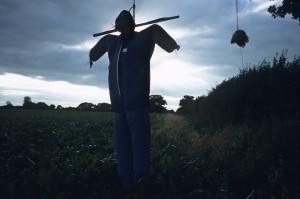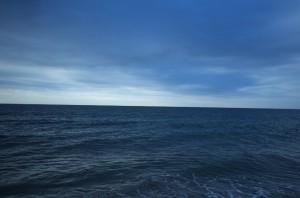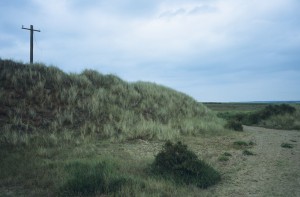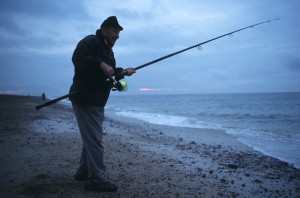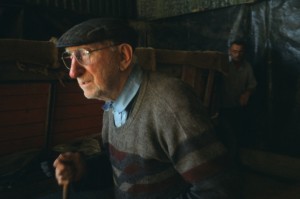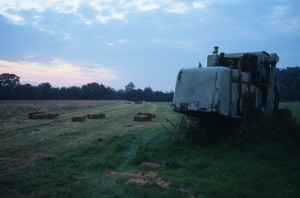In which, as the year comes to it’s end, our friends and collaborators look back and share their moments;
Death overshadows 2008. It will be a year never forgotten.
One day in early April my father and I sat in a room at the hospital. The walls were painted a cream colour and in need of redecorating. On one wall was a large wipe board, its white surface had been turned a dirty grey from the constant erasing of marker pen. The feint scrawl of a doctor’s notes and equations—a patient’s medical history?—were still visible, the familiar tell-tale sign of somebody having used a permanent marker on the board by mistake. The surgeon came in and politely told us that my mother’s cancer was too widespread to remove completely and that it was terminal. TERMINAL! He never actually used the word, perhaps they don’t in hospital because it sounds so final; but his sentences danced around it, now and again hinting that this was the beginning of the end. What struck me was how well the surgeon had mastered the art of discussing terminality with such grace; he had obviously done this many times before. It was the news I had expected: in the eight weeks leading up to this day my mother had been terribly ill, vomiting bile so profusely that it seemed to me that it would take an impossible miracle to cure her. But the surgeon did the best he could and performed a small miracle at least, bypassing numerous sections of bowel and intestine to give some quality to what was left of my mother’s life.
For the few months that followed, I did all I could to help care for my mother: making her meals and trying my hardest to encourage her to eat when all she felt was nausea and had lost her sense of taste. That was one of the ironic cruelties of her illness: she loved food and loved to cook, and she never had the pleasure of those enjoyments again. But she continued to read the latest food magazines with great enthusiasm and would point out to me recipes that she thought sounded nice—an activity that must have been like a form of self-inflicted torture for her.
Things started to become worse, and we helped helplessly as my mother’s body deteriorated: at first helping her to get into bed, and then to get up out of the chair, to wash, and then to walk, and eventually to go to the toilet. There were distressing and difficult times—even entire days—between all of this, but they are the memories that ones tries so hard to forget. And then the evening came when despite all of her effort and what was left of her strength, my mother was unable to make it up the stairs to bed. It was a moment of great significance, because that night as my mother stood near the top of the stairs unable to go any further, she, my father, and I realised that regardless of her determination not to give up, her illness was defeating her and there was nothing anybody could do to stop it.
Jackie Partyka died at 4.20am, 2 September, calmly and painlessly with her family at her bedside. She was 60 years old. From the day of her diagnosis I had always told my mother not to be afraid of death. I’ll never know what her last thoughts were but I like to think that she wasn’t afraid.
***
Thirteen days later another death entered my life when I read of the passing of the writer David Foster Wallace. For some unexplained reason I was not familiar with Wallace’s work, but the attention his death received certainly suggested I should be. The virtual shrine which appeared on Granta.com featured links to just about everything Wallace related on the internet, a lot of it being a reaction to his death.
Wallace was clearly an important writer, and as I started to trawl through the Granta web-links it became obvious that he was more than just important: for anybody interested in writing, his work was essential to know about. On the McSweeney’s website a long list of memorial tributes appeared almost over night. For me, the most heart felt, moving, and revealing message was by Zadie Smith. Herself no stranger to high praise for her writing, Ms Smith (who was friends with Wallace) describes being reduced to a quivering fan upon first meeting him as she “stuttered” and her “hands shook.” For her, Wallace had no equal amongst living writers, and she goes on to write: “He was an actual genius, which is as rare in literature as being kind—and he was that, too. He was my favourite, my literary hero, I loved him and I’ll always miss him.” I thought of my mother as I read these words and was reminded of how fragile life is, even for somebody as great as David Foster Wallace.
A few days later, Salon featured a piece that revealed more about Wallace’s death. He had hanged himself after battling years of chronic depression. Wallace’s parents and sister described the agony of his life and how much of a struggle it had been for him to keep going. His medication had finally failed him and just this past summer he had undergone a series of electro-convulsive therapy treatments. As sad and untimely as Wallace’s death was, it made me realise how relatively lucky my mother had been: her physical suffering had been short in comparison to Wallace’s mental torture, and undoubtedly a lot less painful too. When the demons come for you there is no escape, even if you are a genius. Wallace’s death also reassured me: if somebody as smart as he, was not afraid of death, then my mother certainly had nothing to fear.
In the weeks that followed I sought comfort (and continue to do so) in Wallace’s book of essays, A Supposedly Fun Thing I’ll Never Do Again. Zadie Smith was right. Wallace certainly was a genius. His writing amazed me, educated me, and perplexed me; it made me laugh, and it made me realise that it was possible to see even more intensely than I was doing so already. Wallace was a master of the experiential: he had the ability to observe and soak up everything he encountered, and most importantly he was able to describe his experience of these encounters in the finest of detail and make them a sheer joy to read. My favourite piece in A Supposedly Fun Thing is Wallace’s essay about the Illinois State Fair—strangely titled, ‘getting away from already pretty much being away from it all.’ It is a fine example of his genius. In the essay Wallace describes his encounter with a fairground ride called The Zipper:
“It’s riderless but in furious motion, a kind of Ferris Wheel on amphetamines. Individual caged cars are hinged to spin on their own axes as they go around in a tight vertical ellipse. The machine looks less like a zipper than the head of a chain saw. Its off-white paint is chipped, and it sounds like a shimmying V-12, and in general it is something I’d run a mile in tight shoes to avoid riding.” (pg. 98)
But Wallace’s “Native Companion” who is spending a day at the State Fair with him is a sucker for these rides of torture; she jumps around excitedly at the site of this steel beast and volunteers herself for a ride:
“The operator’s colleague conducts Native Companion up the waffled-steel steps and straps her into a cage, upping a thumb at the operator, who gives a sort of Rebel Yell and pulls a lever. Native C.’s cage begins to ascend. Pathetic little fingers appear in the cage’s mesh. The Zipper operator is ageless and burnt-brown and has a mustache waxed to wicked points like a steers’ horns, rolling a Drum cigarette with one hand as he nudges levers upward and the ellipse speeds up and the individual cages start to spin independently on their hinges. Native Companion is a blur of color inside her cage, but the operator and colleague (whose jeans have worked down his hips to the point where the top of his butt-crack is clearly visible) watch studiously as her spinning cage and the clanking empty cages circle the ellipse approx. once a second. I have a particular long standing fear of things that spin independently inside a larger spin. I can barely even watch this.” (pg. 98)
I never tire of reading this essay, and can’t imagine I ever will. It never fails to amuse me and amaze me, and every time I read it I seem to discover something new. Although it was first published in 1997, A Supposedly Fun Thing I’ll Never Do Again was my literary discovery of 2008—in fact it is one of those literary discoveries of a lifetime, which entered my life at a time when I needed it most and will certainly remain in it forever. I look forward to discovering more of Wallace’s work in 2009: Consider the Lobster and Brief Interviews with Hideous Men sit on my bookshelf ready and waiting.
***
I’ve always considered music to be the most uplifting art form. This year I’ve listened to a lot of music; and I’ve needed to! For me it’s mainly been the usual suspects who’ve been in the CD player, including: The Grateful Dead, Bill Monroe, Roscoe Holcomb, the New Lost City Ramblers, Bob Dylan (especially the new Tell Tale Signs), and Warren Zevon. Who better to listen to after the death of one’s mother than Warren Zevon singing I’ll Sleep When I’m Dead, Life’ll Kill Ya, My Ride’s Here or Keep Me In Your Heart? Perfect music for grieving.
But more than anything else musically, my 2008 has been a Neil Young year. It started by revisiting old favourites such as Tonight’s The Night, and being hypnotised by the sparse driving beat and blood curdling singing of the album’s title track; along with the delicate charms of Unplugged; and the masterpiece of Everybody Knows this is Nowhere, with it’s haunting Down By the River, riddled with gun-shot guitar solos. And then I rediscovered After The Gold Rush. It is an album I’d always liked, but I realised this year that I had never really appreciated how good it is. It was as if I’d suddenly been given new ears: I heard the surreal beauty of “silver spaceships flying in the yellow haze of the sun”; the explosive angered roar of ‘Southern Man;’ and even the short and sweet perfection of Cripple Creek Ferry. If my After The Gold Rush had been vinyl I would have worn it out. Those eleven songs became a faithful companion and (for me at least) they seemed to have all the answers. I would sit in cafés and look around the room for ‘Southern Man’ fiends, but sadly see none. Southern Man should be blasted from the rooftops for all to hear: I’m certain the world would become a better place because of it.
And then, on 31 October BBC4 broadcast Don’t Be Denied. A documentary produced by Ben Whalley, this film was a revealing and honest portrait of what drives Neil Young to keep moving forward as an artist. Don’t Be Denied features exclusive interviews with Young, and he is open and blatant, saying with a raw intensity equal to that of his guitar playing: “I only care about the music. It’s sad. Sometimes people are damaged by it, but if people understand me, they can understand what that is….” His “first job is to follow the musical course—at the detriment of all else.” I found Young’s dedication to his craft inspiring and it was a reminder of how difficult the artistic life can be. Above everything else, you just have to keep making your work, regardless of what others may say or think. Whalley’s film is a brilliant piece of filmmaking. Landscape scenes shot on 8mm film from a moving car are used to segue between interview or performance footage; although they are a simple touch, these made the film for me and are both aesthetically beautiful and perfectly edited to create the feeling of journeying through Young’s life and career.
Don’t Be Denied also helped to stoke the Neil Young fire as the film introduced me to songs I was not familiar with. One of these was Revolution Blues which Young wrote about Charles Manson, a man who “spooked” him and who he describes in the film in a deadpan fashion as not a song writer, but more like a “song spewer!” I went out and bought the album On The Beach on which this song appears and found another Young masterpiece, Ambulance Blues. The other discovery from the film was the album Time Fades Away, which features the song Don’t Be Denied. This live album from 1973 has remained unreleased for many years, but it features some of Young’s best ever performances and songs, such as Yonder Stands the Sinner, L.A. and Last Dance. The recordings on Time Fades Away are raw and loose, at times almost falling apart as Young improvises and experiments in search of a new sound to move on from the success of Harvest.
Musically, my 2008 has ended with the December release of the latest volume from Neil Young’s archive series: Sugar Mountain: Live at Canterbury House 1968. Recorded just a couple of days before Young’s 23rd birthday and the release of his first self-titled solo album, these concert performances are Young stripped bare; just his voice and his acoustic guitar. What is apparent is that even at this early stage of his career, Young has full command of his repertoire, singing the vocals with confidence and emotion, backed up by his funky percussive guitar playing, which was to become such a prominent part of his musical output. Two of the highlights of Sugar Mountain are The Loner which in this basic acoustic guise is ghostly and mysterious, and in my opinion, is far superior to the electric band version (which is still good) that appeared on the first album a few days later; and Sugar Mountain a fragile ballad of youthful reminiscence which was written on Young’s 19th birthday. In the 1997 documentary Year of the Horse, Young says that in the music he made with his band Crazy Horse, he was trying to get “closer to the source.” If anything, these 1968 concert recordings suggest that he had already found “the source” a long time ago. It is good advice—trying to get to the source is something all artists should strive for. Reflecting back on my year of being emersed in Neil Young’s music: it has been a sublime experience.
***
Despite everything that’s happened, 2008 has been a productive year. It had been three years since I first approached Granta magazine with my work. In the summer 2008 issue (No. 102) they finally published a selection of photographs from The East Anglians to accompany Robert Macfarlane’s ‘Ghost Species’ essay, which explores the world of the agrarian farmers of East Anglia who I have been photographing for many years. They even put one of my photographs on the front cover, so it was worth the wait. The work of writers have a far greater influence on my own work than other photography does, so it has always been important for me to get my work featured in Granta. Hopefully I’ll have an opportunity to feature in the magazine again in the near future.
In July I spent some time walking the North Norfolk coast with fellow photographer Jason Orton. I have always turned inland as a photographer and rejected the coast as a potential subject, partly because it has become a region which is photographed and painted to death, and also because I just had not felt any inspiration to make photographs there. Exploring this landscape with Jason allowed me to see it with fresh eyes and changed my opinion. So this year I have tentatively started a project photographing the Norfolk coast. I don’t know what will come of it and in what direction the photographs will take, but I’ve really enjoyed the experience and look forward to continuing the work in 2009. So far I’ve mainly photographed around the Cley and Blakeney Point area. The 90 minute or so walk along the shingle spit of a beach out to the Point has become an important part of the process of working there: the vast plain of coast stretching infinitely ahead consumes you—you enter a trance like state in which time and place stand still, and then suddenly you emerge from the other end at the entrance to the Point’s otherworldly landscape. One evening as I trudged back along the beach to Cley, far in the distance it looked like a line of people had gathered along the seashore to worship the lapping waves. As I exited my trance like state and approached them, I discovered that the people were mackerel fishing.
Much progress has been made on The East Anglians project. I managed to make a number of new photographs during the course of the year and a selection of these have really added something to the project and filled in the missing gaps. The book of this work has gone through endless revisions since I produced the first draft in October 2007. This Autumn I made one last big effort to bring it to an end. I wrote a new introduction, some additional text, and revised the text I already had. And then I spent days working on the final sequence of the photographs, constantly revising the edit each day until the body of work captured the emotion and told the story that I want the project to communicate. I completed the final draft of the book a week before Christmas and will be sending it out to potential publishers early in 2009.
Other exciting news about The East Anglians is that a major exhibition of the photographs will take place at the Sainsbury Centre for Visual Arts, at the University of East Anglia, Norwich, opening 29 September 2009. It has always been important to me that an exhibition of the completed project would launch in my home county of Norfolk, a place which features so prominently in the photographs. The Sainsbury Centre is undoubtedly the best venue in the county and was always my preferred choice. So it was great to receive the news that they wanted to show the work. This month the curators and I made the selection of photographs, and most of next year will be spent working on putting the show together. I will also be seeking further venues for the exhibition to tour in 2010 and beyond. Suggestions on a postcard please!
Finally, 2008 has seen me try my hand at filmmaking—albeit very tentatively. What started out as an experiment to test the video feature of a Canon G9 digital camera, has turned into something more serious. I first started taking the camera with me when I went to photograph at the farms, and now and again I would film for a few minutes. But I soon discovered that these short clips of film added a further dimension to The East Anglians project and could help to tell the story of this rural world. So I began filming more. The sound recordist, filmmaker, and documenter of landscape, Jonathan Watts, has been assisting me. Some of our exploits are described on Jonathan’s blog, Sounding East. Overcoming the limitations of the little digital camera have been a challenge at times, but I’ve come to see it in the same vain as a cine camera and just accept it’s drawbacks. I’ve already amassed hours of film and will continue to add to this into the New Year. I’m still unsure if the film will even come to anything, but Jonathan and I will start editing in the Spring, and hopefully it will come together. If all goes well, the Sainsbury Centre will show the film during the exhibition, and I hope to also make it available on the internet. News and updates on The East Anglians will appear on my website, and here on CBTR.
2008 has certainly been a strange year. Roll on 2009.
